Customer success teams are one of the roles that can be easily done remotely. However, there are some crucial considerations. To ensure maximum efficiency between employees and teams, it’s important to implement collaboration tools.
Top collaboration tools refer to software platforms designed to improve team communication, coordination, task tracking, and productivity, and they’re at the very top of the options that this industry has to offer.
On the other hand, customer success is the proactive process of helping customers achieve their desired outcomes with your product or service.
In this guide, we take a closer look at the leading collaboration tools used by remote customer success teams. You’ll find side-by-side comparisons of features and pricing, a look at what’s trending, and straightforward advice to help you pick the best fit for your team and workflow.
Key Takeaways
- Discover 12 top collaboration tools designed for remote customer success teams
- Compare features, pricing, pros, and cons in a comprehensive chart
- Explore future trends, including AI-powered enhancements and automation
- Gain expert insights on selecting the perfect tool for your team’s size, workflow, and budget
How to Choose the Right Tool for Your Customer Success Team
The best way to start the process of selecting your tool is to assess your team size and the various workflows that your business has. Smaller teams may benefit from simplicity (Trello, Notion), while larger teams might need scalability and integrations.
This is because there aren’t many complex processes in smaller teams. But, larger companies and teams often have numerous tools besides the collaboration ones, requiring tight integrations with tools like CRMs, email marketing tools, phone systems, etc.
Ease of Use
The goals you want to achieve largely impact which collaboration tool is right for your team. If your team is tech-savvy, you should aim for tools that offer more features. Simpler tools are better for non-tech teams.
Compliance and Security
If you don’t want legal consequences, ensure that the tools you’re using are compliant with relevant regulations. This is, for example, GDPR in the European Union.
In terms of security, you should always pick tools that have been reviewed extensively in the past, giving you a heads up if they have ever had a data breach or other cybersecurity incidents.
Budget
Once you’ve understood how the right tool looks for you, in terms of features, ease of use, integrations, and compliance, you should explore options that are within your budget. If you’re a startup, there’s no need to waste your budget on complex, enterprise-grade tools.
Online Reviews & Feedback
The reviews left online shouldn’t be the only thing that will help you decide. You should start a trial period and see how your customer success team responds to a particular tool. You should listen to their feedback and understand whether you should keep using this tool in the future.
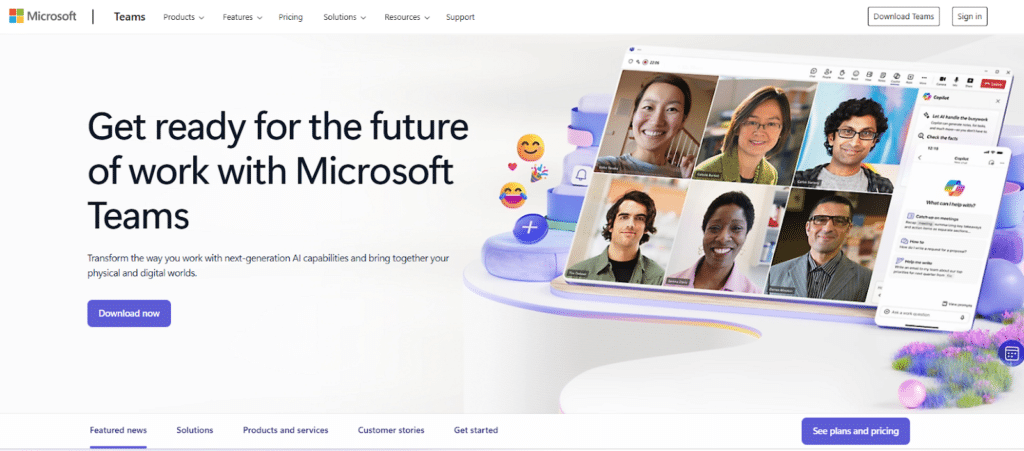
1. Microsoft Teams: Integrated Communication and Collaboration
Microsoft is certainly one of the most notable companies in the world; everyone has used at least one of their applications. Microsoft Teams is a tool that combines chat, video, and document collaboration within Office 365.
It has been shown to increase collaboration efficiency by as much as 30%. It has all the necessary features, and there are many reasons why it holds 29.7% of the market share in terms of collaboration apps.
Dr. Jane Smith has been using Microsoft Teams, and it outlined AI-driven decision-making options as one of the key advantages of this platform. It’s best for a large company, due to its comprehensive Office 365 integration.
Features:
- Chat, video calls, file sharing.
- AI-powered meeting summaries.
- Integration with Microsoft Office apps.
Pros:
- Deep Office 365 integration.
- Robust security.
- Wide feature set for collaboration.
Cons:
- Complex interface can overwhelm new users.
- Steep learning curve.
Pricing: Free tier available; Microsoft 365 Business plans start at $5/user/month.
Critical View: Powerful but potentially too complex for small teams.
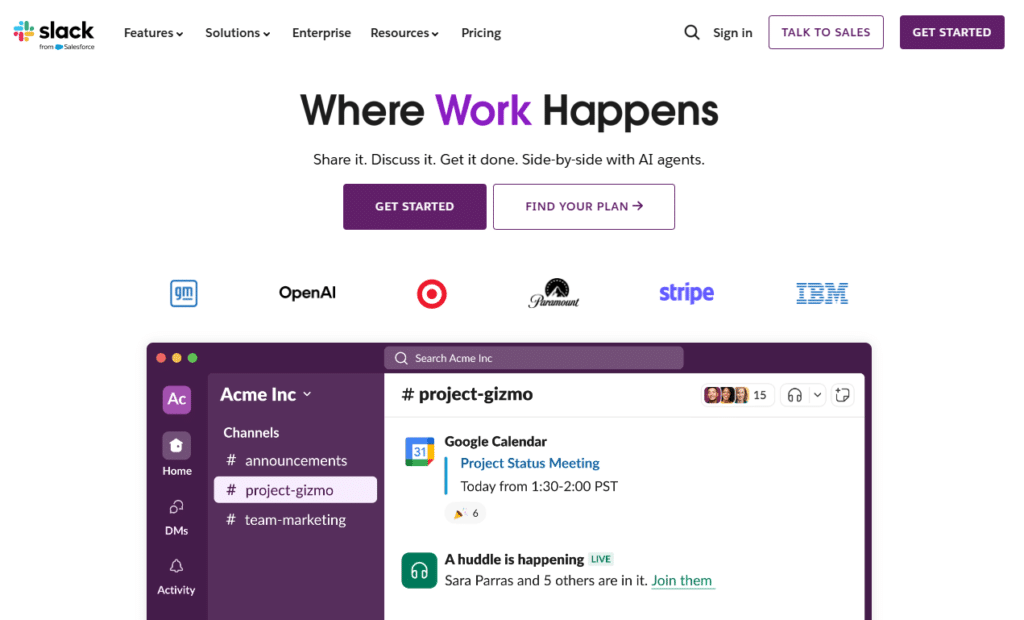
2. Slack: Real-Time Messaging and Integration
Slack is one of the most popular collaboration tools in the current era, and this is shown by a whopping 12 million daily active users. It enables real-time messaging, allows you to organize your company in different channels, and has a lot of integrations.
There’s a quite useful free version, but there are also paid plans for larger and more professional companies. It has a mobile app as well, and CEO Lidiane Jones emphasized that, although Slack is great, it can contribute to burnout.
It’s best for fast-paced teams that require real-time communication and are interested in integrating Slack with other software.
Features:
- Channels, direct messages.
- App integrations (Google Drive, Trello, etc.).
- Workflow automation.
Pros:
- User-friendly interface.
- Extensive app ecosystem.
- Customizable notifications.
Cons:
- Can encourage constant interruptions.
- Work-life balance concerns.
Pricing: Free tier; paid plans start at $6.67/user/month.
Critical View: Great for communication, but can increase distraction.
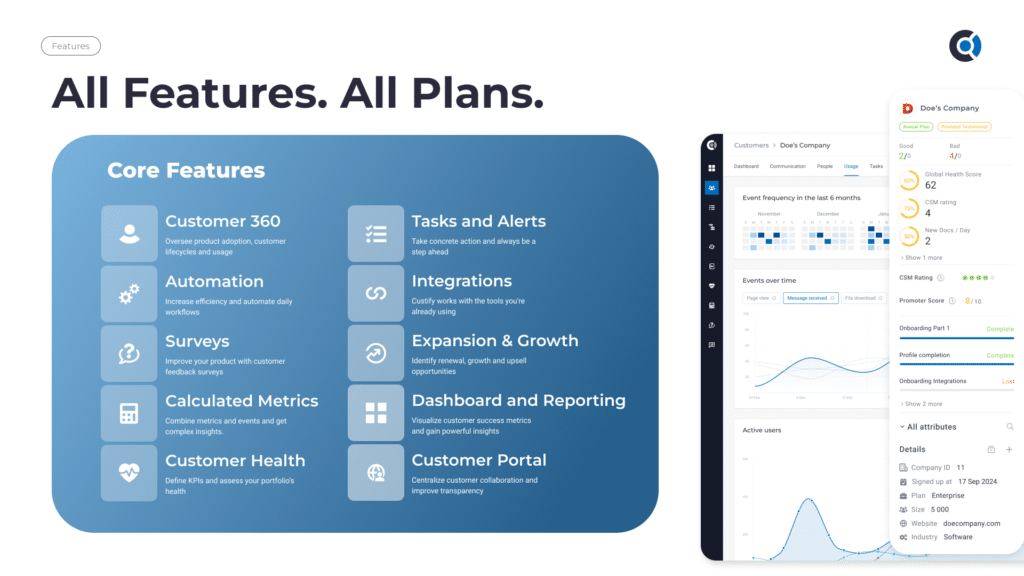
3. Custify: Remote-First Customer Success Platform
Custify is a remote-first customer success software, making it a great choice for global companies. It works as a central collaboration hub, and it’s trusted by leading SaaS companies globally.
It focuses on customer lifecycle automation and team productivity, which are signs that Custify cares about innovation. It’s best for CS teams that need dedicated workflows and automation, but it also has flexible pricing based on team size.
Features:
- Customer health scoring.
- Playbooks and task automation.
- Team collaboration dashboards.
Pros:
- Remote-first design.
- Powerful automation.
- Centralized customer data.
- Concierge onboarding
Cons:
- Learning curve for advanced features.
- Slightly complex user dashboards.
Pricing: Custom pricing based on team size.
Critical View: Highly specialized but may require training.
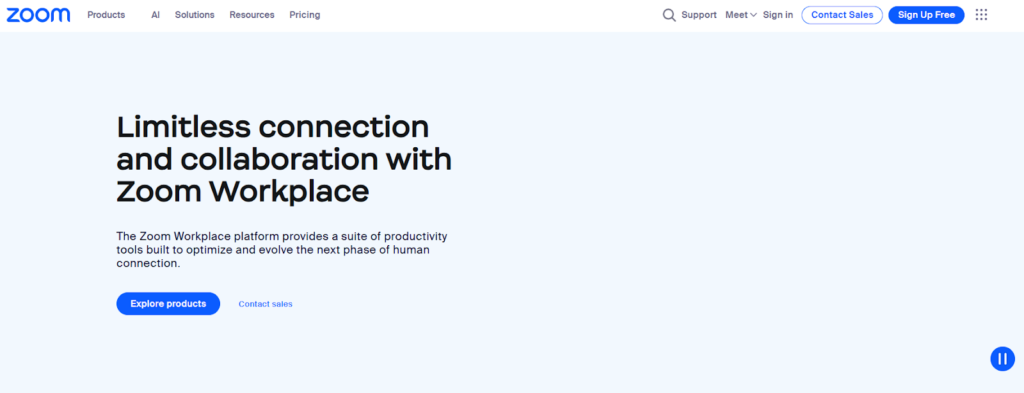
4. Zoom: Video Conferencing and Beyond
We’ve all heard about Zoom during the pandemic. While Zoom isn’t known as a versatile tool, it’s a reliable option for video conferencing and webinars. They’ve grown from 10 to 300 daily users in 2020, and they’re still a popular option.
It’s a great option for holding meetings for remote teams, especially if there’s a need for HD video and audio. The tool is free, but it’s not a full collaboration suite like some of the options mentioned on the list.
Features:
- HD video and audio.
- Webinar hosting.
- Zoom Rooms and Phone.
Pros:
- Easy to use.
- Reliable video quality.
- Scalable for large meetings.
Cons:
- “Zoom fatigue” is reported.
- Limited built-in task management.
Pricing: Free tier; Pro plans start at $14.99/month.
Critical View: Essential video tool, but not a full collaboration suite.

5. Asana: Task and Project Management
Asana is known for its flexible views and features that allow teams from multiple departments to collaborate. It’s best for teams that need detailed task tracking and project workflows.
Large teams can benefit from the task dependency feature, which prevents bottlenecks and confusion that companies often face. As much as 90% of users reported having clearer project goals once they’ve started Asana.
Features:
- Task assignments, dependencies.
- Timeline and calendar views.
- Integrations with Slack, Microsoft Teams.
Pros:
- Flexible views.
- Good for cross-functional teams.
- Scales well.
Cons:
- Can feel overwhelming.
- Requires onboarding time.
Pricing: Free plan; premium from $10.99/user/month.
Critical View: Feature-rich but complex for simple workflows.

6. TeamDynamics
TeamDynamics brings a fresh, data-driven approach to productivity by quantifying how your team works together—measuring communication styles, decision-making patterns, information flow, and execution habits—and giving everyone a shared framework to talk about strengths and gaps rather than guessing at solutions.
Features:
- Behavioral Assessment – A modern, mobile-friendly survey captures your team’s style across four core interaction dimensions, producing both individual and collective profiles so you understand exactly how you get work done.
- TeamVitals Health Check – A free, three-minute pulse survey flags emerging misalignments before they slow you down, keeping sprints on track by catching small issues early.
- Tailored Recommendations – Every report comes with concrete, prioritized actions keyed to the behaviors and workflows that need improvement, so you swap guesswork for targeted coaching.
- Custom Facilitation Guide – Instead of piecing together slides, you get a ready-made, fully editable presentation with discussion prompts and exercises designed to turn insights into measurable productivity gains.
- Asynchronous Collaboration – Assessments can be completed on anyone’s schedule – across devices and time zones – ensuring every voice is heard without adding yet another meeting.
Pros:
- Objective Alignment – Shared metrics replace subjective hunches, making it easier to focus on the right priorities and hold each other accountable.
- Rapid Onboarding – New hires receive an instant “cheat sheet” on how the team works, accelerating their ramp-up and capacity to contribute from day one.
- One-Time, Transparent Pricing – Choose between Solo ($29/user), Pro ($39/user), or Enterprise packages – all one-off fees with no hidden subscriptions.
- Scales with Your Needs – From solo practitioners to Fortune 100 companies, the platform adapts to teams of any size, with enterprise-grade reporting for organizations >20 users.
Cons:
- Not a PM Suite – Unlike Asana or Jira, you won’t find task boards or Gantt charts; it focuses solely on team dynamics, so you’ll need separate tools for detailed project tracking.
- Limited Integrations – Out-of-the-box connections to other productivity platforms are minimal, which can leave data siloed if you rely on a tool ecosystem.
- Dependent on Honest Input – The value hinges on candid survey responses; teams that guard their feedback may see less-actionable insights.
Pricing:
- Solo: One-time $29 per user for individual reports and basic recommendations
- Pro: One-time $39 per user for full team reports, custom facilitation guide, and manager-level insights
- Enterprise: Custom pricing for organizations of 20+ users, with cross-team analytics and enterprise support
Critical View: While TeamDynamics excels at pinpointing and remedying team-behavior bottlenecks—driving faster decision cycles and smoother collaboration—it isn’t a standalone project management solution. You’ll still need dedicated task-tracking tools to map dependencies, assign work, and monitor day-to-day progress.
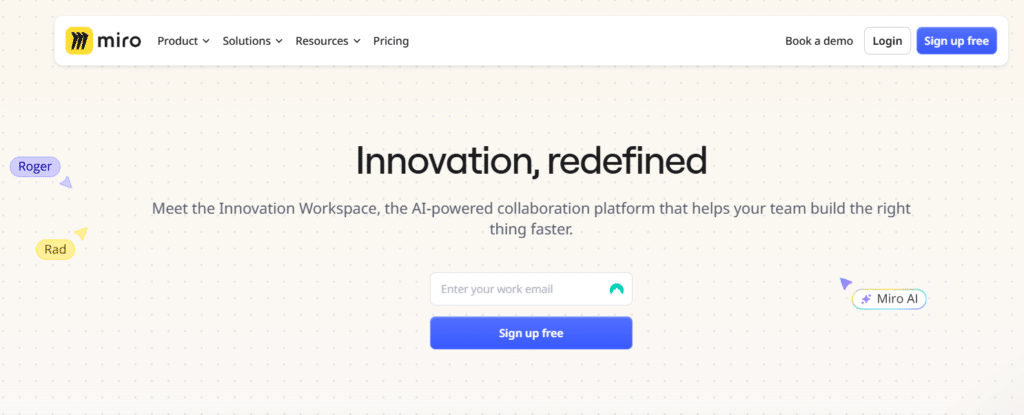
7. Miro: Visual Collaboration Platform
Miro is one of the top collaboration tools, due to its digital whiteboards and numerous templates. It can be integrated with other tools from the list, like Slack or Zoom, and numerous other platforms.
Miro is used by more than 90 million users worldwide, and it’s great for improving innovation among team members. It’s often used in remote workshops, and those who are visual thinkers can significantly benefit from Miro.
Features:
- Digital whiteboards.
- Templates for workshops.
- Integration with Slack, Zoom.
Pros:
- Great for visual collaboration.
- Supports remote ideation.
- Easy to use.
Cons:
- Less suited for text-heavy tasks.
- Can be expensive for small teams.
Pricing: Free tier; paid from $8/user/month.
Critical View: Best for visual work, limited for text-heavy projects.

8. Siddhify: Balanced Productivity and Wellness Platform
Siddhify is a new tool. It has all the features that other tools do, like task management and collaboration. However, its main strength is that it has personal wellness tracking tools. Siddhify is preferred by freelancers who want to avoid burnout.
Features:
- Task management, team chat, shared docs
- Personal wellness insights and reminders.
- Integrations with Slack, Google Calendar, and Microsoft Teams
Pros:
- Balances productivity and wellness.
- Customizable dashboards
- Supports mindful work practices
Cons:
- Newer platform with a smaller user base.
- Some features are still evolving.
Pricing: Free tier available; paid plans start at $6/user/month.
Critical View: Innovative and balanced, though less proven than major competitors.
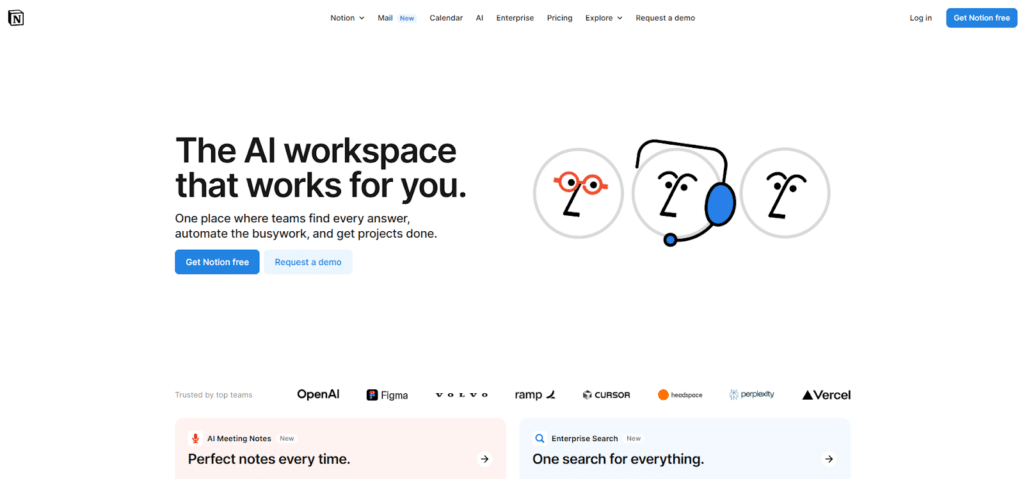
9. Notion: Unified Workspace for Notes and Tasks
While Notion is free for personal requirements, its team plan is paid monthly per user. It’s one of the top-tier tools for note-taking, but it also offers project management and database features.
It can be integrated with Slack, Trello, and numerous other platforms. Similar to some of the tools mentioned before, it provides a flexible, all-in-one workspace. Teams have reported as much as 20% less system-switching time.
Features:
- Notes, databases, task boards.
- Templates for workflows.
- Team collaboration features.
Pros:
- Highly flexible.
- All-in-one workspace.
- Collaborative.
Cons:
- Potential inconsistent usage.
- May need templates for standardization.
Pricing: Free for personal; team plans start at $8/user/month.
Critical View: Flexible, but can lead to inconsistent setups.

10. ProofHub: Centralized Project Management
In terms of ease of use, ProofHub is one of the better options due to its simple UI. It also allows customized workflows, but also Kanban and Gantt charts. This allows different teams to pick the way they’re going to approach project management depending on their preferences.
It’s affordable, but it lacks certain integrations that other options on the list provide.
Features:
- Task assignments.
- Time tracking.
- Custom workflows.
Pros:
- Easy to use.
- Useful project visualization.
- Affordable.
Cons:
- Lacks some integrations.
- Limited advanced features.
Pricing: Starts at $45/month (unlimited users).
Critical View: Good for basics, less suited for complex needs.
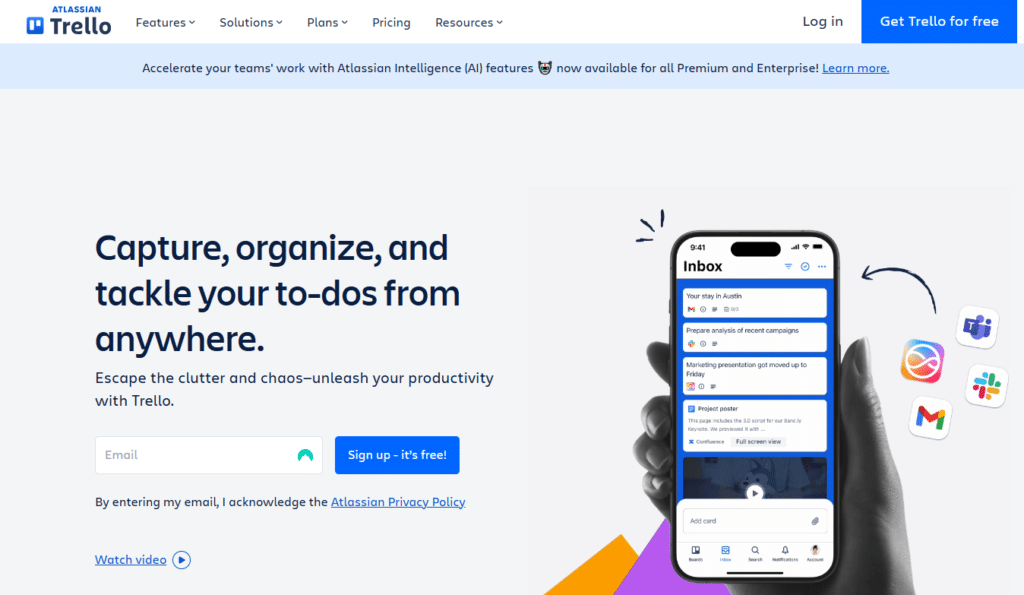
11. Trello: Visually Manage Tasks
Trello is quite popular for it’s Kanban boards. However, it’s much more than that. It has task management tools, and integration options. Besides Kanban boards, you can use list and Board previews.
Features:
- Boards, lists, cards.
- Power-Ups for integrations.
- Mobile and desktop apps.
Pros:
- Simple, intuitive.
- Visual organization.
- Flexible.
Cons:
- Limited for complex projects.
- Power-Ups may add cost.
Pricing: Free; paid from $5/user/month.
Critical View: Best for straightforward task tracking.
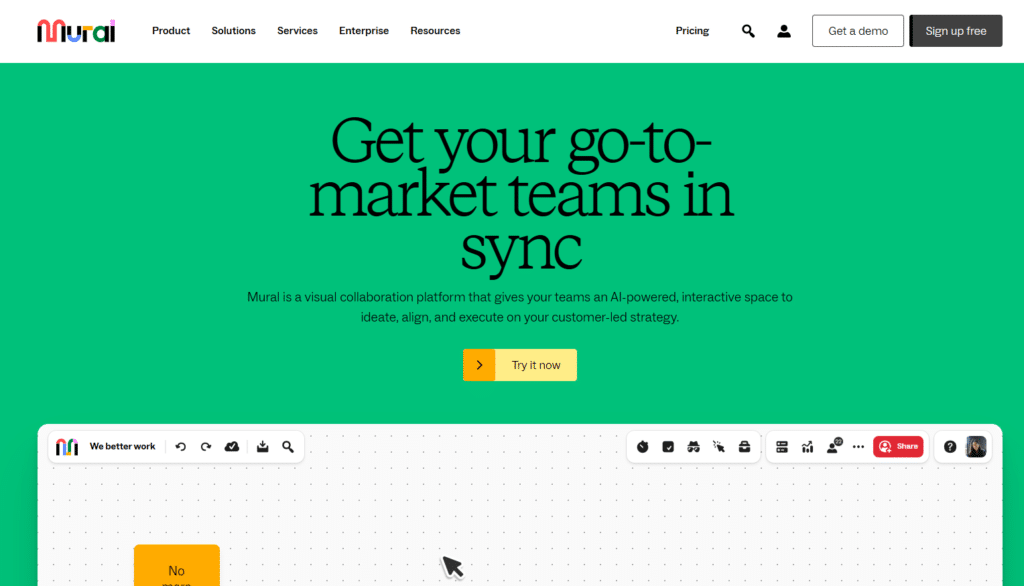
12. Mural: Visualizing Ideas Collaboratively
Like the name suggests, Mural offers digital canvases, which are a great option for brainstorming and creating documentation. It supports task assignments, comments, and deadlines.
Mural comes with numerous templates, which streamline the onboarding process for this tool significantly. Like some of the platforms mentioned before, it also offers a digital whiteboard, making it perfect for presentations.
Features:
- Visual canvases.
- Slack, Microsoft Teams integration.
- Templates for brainstorming.
Pros:
- Intuitive visual tools.
- Enhances creativity.
- Easy collaboration.
Cons:
- Not ideal for text-based management.
- Pricing may be high for small teams.
Pricing: Plans from $12/user/month.
Critical View: Visual focus may limit broader project use.
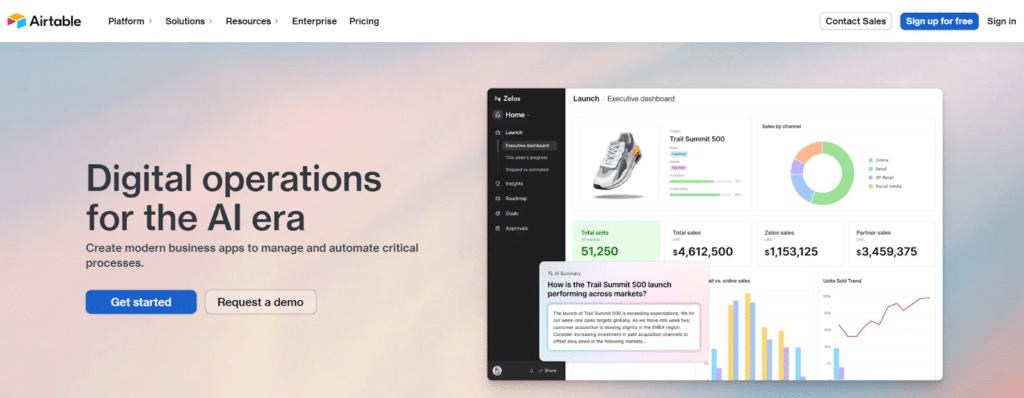
13. Airtable: Flexible Database Collaboration
Airtable combines a spreadsheet and a database for project tracking, and it’s one of the top collaboration tools on the market. It’s used by over 200,000 organizations, and it’s perfect for managing complex data.
It’s mainly used by teams that need custom databases with collaboration options.
Features:
- Customizable tables.
- Views: grid, calendar, kanban.
- Integrations with Slack, Google Workspace.
Pros:
- Powerful customization.
- Easy to link data.
- Visual flexibility.
Cons:
- May require training.
- Can be expensive at scale.
Pricing: Free tier; paid from $10/user/month.
Critical View: Complex setup for simple use cases.
Editor’s Top Picks
Overall Best: Microsoft Teams
Has everything that you need, and it can be integrated with Office 365. Preferred by larger companies.
CS Team’s Top Choice: Custify
Tailored specifically for customer success teams working remotely, offering powerful automation and centralized customer data to boost team productivity.
Most Balanced Tool: Siddhify
Combines project management with personal life balance features, making it perfect for teams looking to integrate work and wellness efficiently.
Best for Visual Teams: Miro
An intuitive visual collaboration platform, perfect for brainstorming, planning, and agile workflows with remote and hybrid teams.
The Future of Collaboration Tools for Remote Customer Success Teams
We’ve all been hearing about artificial intelligence in the past few years. Collaboration tools aren’t any different. One of the most important emerging trends is AI-powered features for these platforms.
You should always look for innovative options, and have talked about implementing the latest trends, like AI integrations, automation, and acting as a unified platform for multiple different processes.
Some of the platforms on this list gather valuable data, allowing you to get insights into the strengths and weaknesses of your customer success team.
Articles like this can prove quite valuable for picking tools, but you should also explore expert opinions and market data that specifically target the future of these tools, allowing you to get a closer insight into the features you should look for.
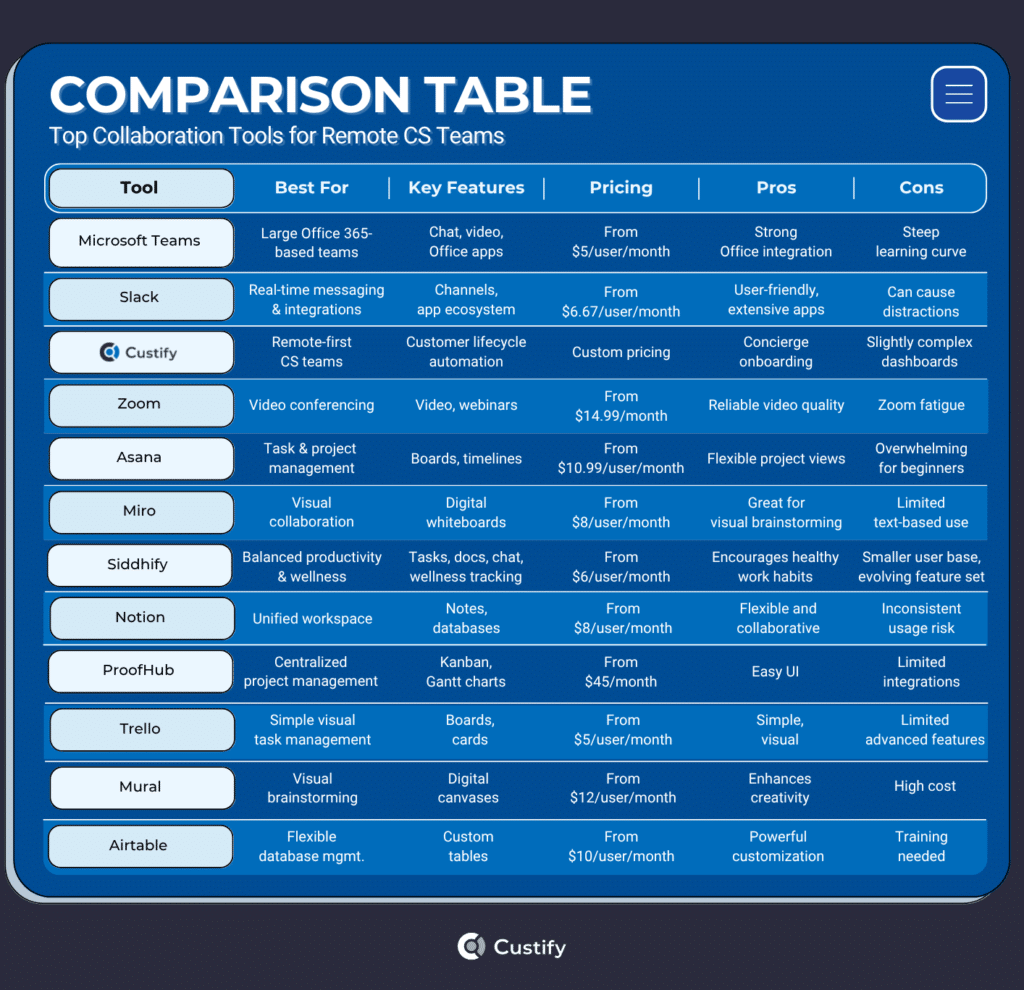
FAQ – Top Collaboration Tools for Customer Success Teams
1. What are the top collaboration tools for remote CS teams?
Top picks include Microsoft Teams, Slack, Custify, ClickUp, Siddhify, and Miro.
2. How do collaboration tools improve customer success?
They enhance communication, track tasks, automate workflows, and ensure transparency, which is key to proactive CS.
3. Are these tools suitable for small teams?
Yes. Trello, Notion, and ClickUp offer lightweight or scalable versions ideal for small teams, while Siddhify is also great for freelancers. When it comes to CS tools, Custify can be customized to work for teams as small as just one person.
4. How secure are these tools?
Most offer enterprise-level security with features like encryption, SSO, and compliance certifications.
5. Can these tools integrate with CRM software?
Absolutely. Many tools support native or third-party integrations with Salesforce, HubSpot, and others.
6. What’s the best free collaboration tool for remote teams?
Trello and Slack offer strong free versions with robust core features.
Conclusion
Selecting the right tools for your business can improve your business’s long-term efficiency and increase employee engagement. All of the tools from this list are proven and great, but it’s up to you to decide which ones are the perfect option for you.
Always ensure that the tool you’re choosing aligns with your team’s size, workflows, and preferences of your managers and top talents. This should be true for all types of tools, not only for collaboration tools.
If you can’t decide between multiple tools, you should make the best out of the free trial plans and the feedback that you receive from your employees. This is probably the best way of picking the top collaboration tools for your business.
While there isn’t a one-size-fits-all solution, the majority of customer success teams will blossom with the right toolset at their disposal.




